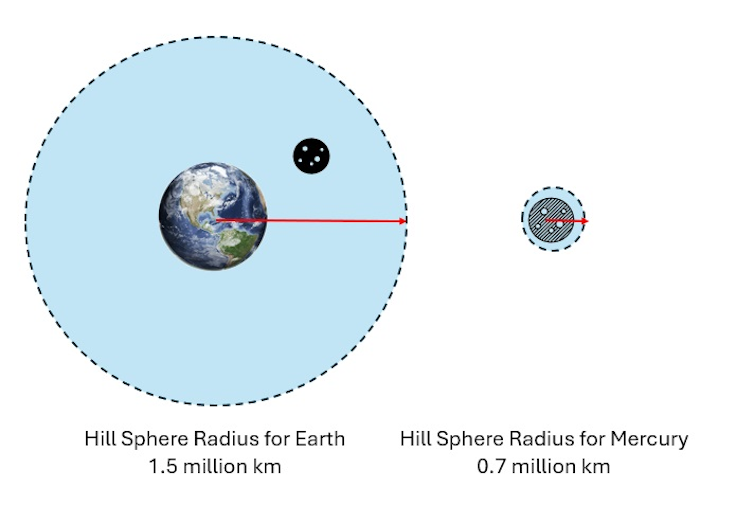Curious Kids is a show for kids of all ages. If you have a question you’d like an expert to answer, send it to curiouskidsus@theconversation.com.
Why do some planets have moons and some don’t? – Siddharth, 6 years old, Texas
On Earth, you can look up at night and see the moon shining brightly from hundreds of thousands of miles away. But that wouldn’t be the case on Venus. Not every planet has a moon – so why do some planets have multiple moons while others have none?
I am a physics teacher and have been following current theories that explain why some planets have moons and others don’t.
First, a moon is called a natural satellite. Astronomers refer to satellites as objects in space that orbit larger bodies. Since a moon is not man-made, it is a natural satellite.
There are currently two main theories as to why some planets have moons. Moons are either captured by gravity when they are within what is known as the Hill sphere radius of a planet, or they form along with a solar system.
The radius of the Hill sphere
Objects exert a gravitational force on other objects nearby. The larger the object, the greater the attraction.
This gravitational force is the reason why we all stay on Earth and do not float away.
The solar system is dominated by the strong gravitational force of the sun, which keeps all the planets in its orbit. The sun is the most massive object in our solar system, meaning it has the greatest gravitational influence on objects such as planets.
For a satellite to orbit a planet, it must be close enough for the planet to exert enough force to keep it in orbit. The minimum distance a planet needs to be to keep a satellite in orbit is called the Hill sphere radius.
The radius of the Hill sphere is based on the mass of the larger and smaller object. The moon orbiting the earth is a good example of how the radius of the Hill sphere works. The earth orbits the sun, but the moon is so close to the earth that it is captured by the earth’s gravity. The moon orbits the earth and not the sun because it is within the radius of the earth’s hill sphere.

Nicole Granucci
Small planets like Mercury and Venus have a tiny Hill sphere radius because they cannot exert a large gravitational force. Possible moons would probably be attracted to the Sun instead.
Many scientists are still studying whether these planets may have had small moons in the past. When the solar system was forming, there may have been moons that were pushed away by collisions with other space objects.
Mars has two moons, Phobos and Deimos. Scientists still debate whether these came from asteroids that passed close to the radius of the Mars Hill sphere and were captured by the planet, or whether they formed at the same time as the solar system. More evidence supports the first theory, since Mars lies close to the asteroid belt.
Jupiter, Saturn, Uranus and Neptune have larger Hill sphere radii because they are much larger than Earth, Mars, Mercury and Venus and are farther from the Sun. Their gravitational force can attract and hold more natural satellites such as moons in orbit. For example, Jupiter has 95 moons while Saturn has 146.
Moons that form with a solar system
Another theory assumes that some moons were formed at the same time as their solar system.
Solar systems start with a large disk of gas rotating around a sun. As the gas rotates around the sun, it condenses into planets and moons that rotate around it. The planets and moons then all rotate in the same direction.
But only a few of our solar system’s moons are likely to have formed this way. Scientists believe that the inner moons of Jupiter and Saturn formed during the formation of our solar system because they are so old. The rest of our solar system’s moons, including the outer moons of Jupiter and Saturn, were probably captured by the gravity of their planets.
Earth’s moon is special because it probably formed in a different way. Scientists believe that a long time ago, a large object the size of Mars collided with Earth. During this collision, a large piece flew away from Earth and entered its orbit, becoming the moon.
Scientists believe that the moon was formed this way because they found a type of rock called basalt in the soil on the lunar surface. The lunar basalt looks exactly like the basalt in the Earth’s interior.
Ultimately, the question of why some planets have moons is still widely debated, but factors such as a planet’s size, its gravitational pull, the radius of its Hill sphere, and the formation of its solar system could play a role.
Hey, curious kids! Do you have a question you’d like an expert to answer? Ask an adult to send your question to CuriousKidsUS@theconversation.com. Please tell us your name, age and the city you live in.
And since curiosity knows no age limit, adults can join in too. Let us know what interests you. We can’t answer every question, but we’ll do our best.